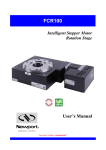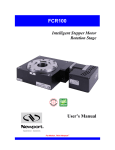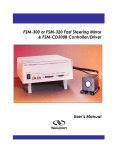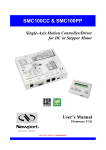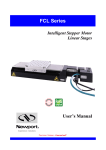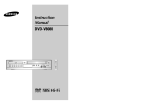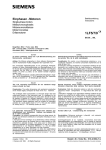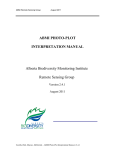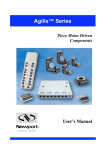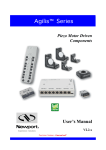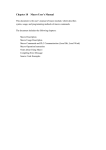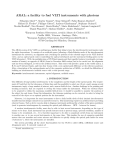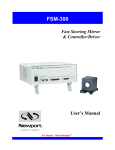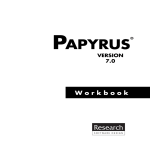Download CONEX-LDS User`s Manual
Transcript
CONEX-LDS Electronic Autocollimator RoHS Compliant USER’S MANUAL Electronic Autocollimator CONEX-LDS Warranty Newport Corporation warrants this product to be free from defects in material and workmanship for a period of 1 year from the date of shipment. If found to be defective during the warranty period, the product will either be repaired or replaced at Newport’s discretion. To exercise this warranty, write or call your local Newport representative, or contact Newport headquarters in Irvine, California. You will be given prompt assistance and return instructions. Send the instrument, transportation prepaid, to the indicated service facility. Repairs will be made and the instrument returned, transportation prepaid. Repaired products are warranted for the balance of the original warranty period, or at least 90 days. Limitation of Warranty This warranty does not apply to defects resulting from modification or misuse of any product or part. CAUTION CAUTION Please return equipment in the original (or equivalent) packing. You will be responsible for damage incurred from inadequate packaging if the original packaging is not used. Warranty does not apply to damages resulting from: • Incorrect usage: – Different use from that intended by NEWPORT. – Use of a cable different from the one supplied by NEWPORT. – Use or storage in environmental conditions other than those indicated. – Poor maintenance of the equipment, in particular, scratches on the front optic, excessive humidity, shocks to the body. • Modification of the product or any part thereof. This warranty is in lieu of all other warranties, expressed or implied, including any implied warranty of merchantability or fitness for a particular use. Newport Corporation shall not be liable for any indirect, special, or consequential damages. No part of this manual may be reproduced or copied without the prior written approval of Newport Corporation. This manual has been provided for information only and product specifications are subject to change without notice. Any changes will be reflected in future printings. EDH0322En1030 — 06/15 ii Electronic Autocollimator CONEX-LDS Table of Contents Warranty .................................................................................................................ii EC Declaration of Conformity...............................................................................v Definitions and Symbols.......................................................................................vi Warnings and Cautions .......................................................................................vii 1.0 — Introduction .................................................................................1 2.0 — Description ...................................................................................2 2.1 Equipment..................................................................................................2 2.2 Modes of Operation ..................................................................................3 Display or Measurement Mode ...............................................................3 Analog Output or Data Gathering Mode ................................................3 2.3 Dimensions ................................................................................................3 3.0 — Principle of Operation............................................................4 3.1 Autocollimation Principle ........................................................................4 3.2 Electronic Autocollimator........................................................................5 4.0 — Characteristics ............................................................................7 4.1 Units of Measure .......................................................................................7 4.2 Specifications ............................................................................................7 4.3 Specification Limits ..................................................................................8 Calibration .................................................................................................8 Temperature ..............................................................................................9 Distance......................................................................................................9 Aperture Adjustment................................................................................9 Low Reflectivity.........................................................................................9 Polarization Effects .................................................................................10 Periodic Verification of Calibration ......................................................10 5.0 — Starting the Equipment ........................................................11 5.1 Set Up........................................................................................................11 Class II Laser Product.............................................................................11 Mounting Stability...................................................................................11 CONEX-LDS Supports.........................................................................12 Recommended Mirror and Mounts for Different Applications ....14 Wobble Measurements of Rotary Bearings ....................................14 Analysis of Structures........................................................................14 Vibration Tests ...................................................................................14 iii EDH0322En1030 — 06/15 Electronic Autocollimator CONEX-LDS 5.2 Electrical Connections ...........................................................................14 Grounding ................................................................................................15 Communication Mode ............................................................................15 5.3 Display or Measurement Mode .............................................................15 Alignment Procedure..............................................................................17 5.4 Gathering Angle Measurements Remotely ..........................................19 Analog Outputs Resolution vs. Gain ....................................................19 6.0 — Examples of Applications ...................................................20 7.0 — Maintenance ..............................................................................22 7.1 Sensor Maintenance ...............................................................................22 7.2 Cables .......................................................................................................22 7.3 Preventive Maintenance.........................................................................23 8.0 — Verification Kit (CONEX-LDS-VER) ..................................23 8.1 Description ..............................................................................................23 8.2 Function ...................................................................................................23 8.3 Verification Procedure ...........................................................................24 9.0 9.1 9.2 9.3 9.4 9.5 9.6 — Commands ..................................................................................25 Introduction.............................................................................................25 Communication Settings ........................................................................25 State Diagram ..........................................................................................25 Command Syntax ....................................................................................26 Command Execution Time.....................................................................27 Command Set...........................................................................................27 10.0 — Connector Interfaces .............................................................53 10.1 RS-422 Connector for Communication .................................................53 10.2 Analog Outputs Connector for Data Gathering ...................................53 Service Form .........................................................................................................55 EDH0322En1030 — 06/15 iv Electronic Autocollimator CONEX-LDS EC Declaration of Conformity CONEX-LDS Year mark affixed: 2015 EC Declaration of Conformity The manufacturer: MICRO-CONTROLE Spectra-Physics, 9, rue du Bois Sauvage 91055 Évry CEDEX, FRANCE Hereby declares that the product: Description: " CONEX-LDS " Function: Electronic Autocollimator Type of equipment: Electrical equipment for measurement, control and laboratory use –complies with all the relevant provisions of the Directive 2014/30/EU relating to electromagnetic compatibility (EMC). – was designed and built in accordance with the following harmonised standards: NF EN 61326-1:2013 « Electrical equipment for measurement, control and laboratory use – EMC requirements – Part 1: General requirements » NF EN 55011:2010/A1:2011 Class A CEI 60825-1:2008 « Safety of laser equipment radiation » – was designed and built in accordance with the following other standards: NF EN 61000-4-2 NF EN 61000-4-3 NF EN 61000-4-4 NF EN 61000-4-6 Date : 26/06/2015 Dominique DEVIDAL Quality Director MICRO-CONTROLE Spectra-Physics Zone Industrielle F-45340 Beaune La Rolande, France v DC2-EN rev:A EDH0322En1030 — 06/15 Electronic Autocollimator CONEX-LDS Definitions and Symbols The following terms and symbols are used in this documentation and also appear on the product where safety-related issues occur. General Warning or Caution The exclamation symbol may appear in warning and caution tables in this document. This symbol designates an area where personal injury or damage to the equipment is possible. The following are definitions of the Warnings, Cautions and Notes that may be used in this manual to call attention to important information regarding personal safety, safety and preservation of the equipment, or important tips. WARNING Warning indicates a potentially dangerous situation which can result in bodily harm or death. CAUTION Caution indicates a potentially hazardous situation which can result in damage to product or equipment. NOTE Note indicates additional information that must be considered by the user or operator. European Union CE Mark The presence of the CE Mark on Newport Corporation equipment means that it has been designed, tested and certified as complying with all applicable European Union (CE) regulations and recommendations. Warnings and Cautions ATTENTION This stage is a Class A device. In a residential environment, this device can cause electromagnetic interference. In this case, suitable measures must be taken by the user. EDH0322En1030 — 06/15 vi Electronic Autocollimator CONEX-LDS Warnings and Cautions WARNING IN ORDER TO COMPLY WITH SAFETY STANDARDS CONCERNING THE USE OF THIS EQUIPMENT, THE USER MUST TAKE THE FOLLOWING PRECAUTIONS AND HEED THE WARNINGS THAT APPEAR LATER IN THIS MANUAL. CAUTION The user must read the warnings in the CONEX-LDS User’s Manual before operating the equipment CAUTION: LASER SAFETY The CONEX-LDS is a CLASS II LASER INSTRUMENT according to the IEC60825-1 standard: DO NOT STARE INTO BEAM Max. Power <1 mW @ 670 nm RAYONNEMENT LASER NE PAS REGARDER DANS LE FAISCEAU LASER RADIATION DO NOT STARE INTO BEAM ATTENTION RAYONNEMENT LASER EN CAS D'OUVERTURE, EXPOSITION DANGEREUSE AU FAISCEAU APPAREIL A LASER DE CLASSE 2 CLASS II LASER PRODUCT P <1 mW; λ = 670 nm IEC60825 DANGER. LASER RADIATION WHEN OPEN, AVOID DIRECT EXPOSURE TO BEAM For safety reasons, using this instrument in a dark environment is NOT recommended: The lower the level of light, the larger the diameter of the eye's pupils allowing more of the laser beam to damage the retina. This also reduces the energy level which can damage the retina. Device CONEX-LDS Manufacturer: Zone Industrielle 45340 Beaune-la-Rolande France S/N: Manufactured: Complies with CFR 21 Subchapter J vii EDH0322En1030 — 06/15 Electronic Autocollimator CONEX-LDS WARNING: Stop using the autocollimator if it emits smoke, it is particularly warm, it has an abnormal smell, makes an abnormal noise, or it shows any other unusual signs. Do not put anything in the CONEX-LDS autocollimator, and do not spill any liquid on the sensor. If it is integrated in a machine, ensure there is sufficient cooling: leave enough space for air flow or use heat extraction means. Never open the CONEX-LDS sensor, as there are risks of short circuits and optical losses. Opening the CONEX-LDS voids the warranty. Do not connect anything to the CONEX-LDS other than the cables supplied by NEWPORT. Do not use the CONEX-LDS autocollimator if you have noticed that it is not working correctly. CAUTION: SAFETY REGULATIONS Do not use the instrument in an explosive environment. Make sure there is no liquid near the instrument. Make sure that the instrument is not exposed to excessive humidity (more than 85%). Do not replace any part and do not modify the equipment in any way. Should it require servicing or repairs send it back to a Newport service center. NEWPORT SHALL NOT BE HELD LIABLE IF THE ABOVE-MENTIONED WARNINGS ARE NOT FOLLOWED. EDH0322En1030 — 06/15 viii Electronic Autocollimator CONEX-LDS Electronic Autocollimator CONEX-LDS 1.0 —Introduction This manual describes the operation and conditions necessary for the proper use of the NEWPORT CONEX-LDS autocollimator. It also provides the basic maintenance to keep the instrument in good working order. IMPORTANT The CONEX-LDS autocollimator is an optical angle measuring instrument. A calibration certificate is provided by Newport with every new ConexLDS purchase, as well as with any recalibration service done by the factory. It provides the values of the parameters that are stored in the memory of the controller so that the instrument gives accurate measurements. BEFORE any measurement, the operator must make sure that the correct parameters are loaded in memory. Refer to the corresponding chapter to check or update the correct parameters or modify the angular units. RECOMMENDATIONS Read Section 5.0, “Starting the Equipment” before connecting the autocollimator. NOTE The CONEX-LDS Controller GUI, software drivers and manuals can be downloaded from www.newport.com/CONEX-LDS. 1 EDH0322En1030 — 06/15 Electronic Autocollimator CONEX-LDS 2.0 —Description The CONEX-LDS autocollimator is a compact and self-contained angle measuring instrument. It measures the angular variations of a reflective surface, a plane mirror for example, using the movement of the reflected beam on its position sensing sensor. A PC is required to display the angular readings of the CONEX-LDS via the Controller GUI and also to record measurement data. A stand alone or PC card data acquisition unit can also be connected to the analog outputs. The XPS Universal Motion Controller can also be used to gather data from the CONEX-LDS, see Section 5.4. The CONEX-LDS Controller GUI can be downloaded from www.newport.com. This manual describes the use of the CONEX-LDS autocollimator for all its modes of operation. !∀#∃!%&∃∋(!∃# %∃#+( !∀∀#∃%&∋(&)#∗ 789:;9<:7< 2.1 14256 ,−.&/&01,23 )&∗+#+ 2∗=#∃>!%?#∗≅ The autocollimator is delivered in a protective case which contains the following: • A CONEX-LDS optical head (including controller). • A calibration certificate. • A 5 meter communication cable. −># ∃!%(Α∃ 6#>&∋(&+Λ#∀Ε 6(∋∃+#!∃&∀+0∋ 0#∗(ΒΧ,−. Α?% 6#>&∋Α&∀∃#∋ ,∃!−./#&∀+0∋ 7<Χ<78Χ::Φ 6∆&∋(&≅Ε∃?( 1∋∃2+%&3.04∋∃ . <Η<78Η::ΦΙϑΚ 78Η:;Η<:7<Η7 0#∗(ΒΗ,−.Η 6#>&∋Α&=?)Γ?(∃ 52%∋&∀+0∋ ∃!∃8 )&7∋+8.∃∋−&∋∃ ∃Ε(≅ Κ∃∃(Α∃≅&>(≅Α Α( %!%?#∗&)!%!+#Μ 0∃?%Ε∃(&!))(∀ #2!∀&/∃2#∋∃2.0 +#+%!9.∋&+//∋(#+ :Ι;;&Ν ϑ!Β&Ρ Α∃&>(≅Α∃Ε(&Π <Ν&∋(&+!&Ο!+( 9Χ&;&Θ∃!∋ The power supply, CONEX-LDS-PS and the RS-422 to USB adapter, CONEX-USB-RS422 are ordered separately. Χ:ΙΤ7&Ν ϑ!Β&Σ Equipment !∀#∃%∃&∋()∋(∗ 8: Φ: <: 7: Θ∃!∋ : Χ7: Χ<: ΧΦ: Χ8: Χ<&::: Χ7&::: Χ7&;:: : Θ∃!∋ Χ;:: 7&::: ;:: 7&;:: <&::: !∀#∃%∃&∋()∋(+ 8: Φ: <: 7: Θ∃!∋ : Χ7: Χ<: ΧΦ: Χ8: Χ7&::: Χ7&;:: Χ<&::: ΥΡ ΕΜ+!Μ(≅ ΥΣ 1∋##2∀98 8Τ:Τ 8ςΩΤ ≅ &Π9Χ&<∆0 Υ!∃!>Ε%∃(/&&&&&& &&&&&&&&&&&&&&&&&<< : Θ∃!∋ Χ;:: 5Ρ ΞΙ8Ω8 5Σ ΤΙς< )&(+∃+0∋#∋∃8 > >&&∴&−?!>&Φ:> 4(>∀Ε∃!%Α∃(& & &Ξ:Ν&[&ςΤ:&∗ &&&&&&&&&&&&&&&&&&&&& ϑ?∃#?∃&Α%?+?≅Ε&/ :&>> !Ο!?+&/&&&&&&&&&&&&&&7: −?≅%!∗)(&∋(&%∃ &&&&&&&&&3ς;8::Φ /&&&&&& !∗)& ∋Α&] Ε=Ε∃(∗)(& 0#>>(∗%!?∃( ≅ EDH0322En1030 — 06/15 7&::: ;:: Ψ ,Ζ 7&;:: <&::: <:<: 7: Accessories and options can be ordered separately. • 20-meter USB/RS-422 communication cable. )& !00∋∀#8 2 Electronic Autocollimator CONEX-LDS 2.2 Modes of Operation 2.2.1 Display or Measurement Mode When linked to a computer, by USB or Ethernet to RS-422 connector cable, the instrument communicates through ASCII commands. Refer to Chapter 9.0 for the description of mnemonic commands. A dedicated Controller GUI provides access to the global functions of the instrument. This Controller GUI has its own manual. Please refer to it for a proper use of the CONEX-LDS. Refer to chapter 5.2 of this manual for connections. 2.2.2 Analog Output or Data Gathering Mode 2 analog outputs are available. They provide two output voltages that are proportional to the angular measurements of the qX or qY (pitch and yaw) axes of the CONEX-LDS. This mode enables: • Connection to an analog acquisition chain (can be connected to the analog input of the Newport XPS controller or other data acquisition instruments). • Graphical display of angular positions on an oscilloscope. • Use of the CONEX-LDS autocollimator for analog control, mirror correction for example. These outputs are converted from the digital values calculated by the CONEX-LDS. 2.3 Dimensions ø1.496-0.0008 -0.004 (38-0.02 -0.1 ) 2.83 (72) SQR 1.57 (40) .35 (9) .32 (8.1) SQR 1.57 (40) 1.035”-40 THD 0 ø1.378-0.004 0 (35-0.1 ) 1.89 (48) 5.39 (137) 10.60 (269) HOLE M3 THD USABLE DEPTH: .12 (3) FOR GROUNDING NOTE A minimum 100 mm bend radius is needed to relieve stress on the connectors. 3 EDH0322En1030 — 06/15 Electronic Autocollimator CONEX-LDS 3.0 —Principle of Operation 3.1 Autocollimation Principle The function of the CONEX-LDS autocollimator is based on the well known principle of autocollimation. A standard autocollimator uses a rear-illuminated cross light reticle A, located behind the focal plane of a collimating lens B. The light is projected to infinity which is reflected back to the instrument with a plane reflecting mirror C. A B E C D CONEX-LDS F Measurement Mirror (Output Objective Lens Focal Length) ∆Y PSD Sensor 2.∆θ Beam Splitter Objective Lens Laser Diode X = F.tan(2.∆θ) α = 1/2 arctan(∆Y/F) F = 250 mm => ∆θ = 2000 µrad => ∆Y = 1 mm CONEX-LDS Measurements = ∆θ The reflected beam is focused on the back of the focal plane of the collimating lens. A beamsplitter D is used to recover 50% of the returned light to form an image at the source reticle. Most instruments use a measuring eyepiece E with a dark cross reticle to observe this autocollimated image. If the reflected image is coincident with the incident beam, the mirror is in an autocollimating position. In this case, the last image of the source reticle will superpose with the dark cross line of the eyepiece reticle. For an angular movement of the mirror C, a lateral displacement of the reflected image is observed at the focal plane of the collimating lens. If the value of the focal length of the collimated lens is “F”, then the lateral displacement will be: DY = F x tan(2Dq) where Dq is the angular displacement of the mirror. EDH0322En1030 — 06/15 4 Electronic Autocollimator CONEX-LDS This displacement can be measured in two ways, using the measuring eyepiece: • Mechanical angular movement Dα of the autocollimator in order to recenter the reflected image inside the dark reticle (then Dq = Dα). • Lateral movement of the cross reticle to measure DY (then Dq = DY/2F). Autocollimation is a common method to check and align optical elements, such as laser cavities, Fabry-Pérot, and is used in all optical workshops to measure prism characteristics and angular deviations. This is also a useful tool for measuring table flatness. On the whole, these operations are done manually. 3.2 Electronic Autocollimator The advantage of the electronic autocollimator is that it automates angular measurements. Thus: • It is possible to perform fast or slow measurements. • It can average a large number of measurements. • It enables automatic alignment. For the CONEX-LDS autocollimator, the basic principles that are used to obtain the values of angular displacements are as follows: • The source reticle is a Laser diode. • The measuring eyepiece is a position sensing device. Laser Diode Specifications • 1 mW laser diode; λ = 670 nm. • 5 kHz modulation. Position Sensing Device (PSD) • 2 x 2 mm PSD sensing area: Delivers analog signals proportional to the position (VX and VY) of the beam. • Sensitivity: 0.003 µrad/√Hz The reflected beam is focused onto the XY position sensing device and thus the two PSD signals are used to calculate the angular deviations. 5 EDH0322En1030 — 06/15 Electronic Autocollimator CONEX-LDS F H C E D B G I A Description A Laser diode module F Alignment eyepiece B Beamsplitter I G Magnifier C Collimating lens H Position sensing device D Mirror I Lighting LED (red) E Beamsplitter II One portion of the light is used for coarse visual alignment (visible laser diode). A centered circle indicates the acceptable zone for automatic recording. The equivalent focal length, combining the collimating lens, C, and the magnifier, G, is equal to 250 mm. EDH0322En1030 — 06/15 6 Electronic Autocollimator CONEX-LDS 4.0 —Characteristics 4.1 Units of Measure The angular values are given in µrad, which is also the unit used for calibration. ANGULAR CONVERSIONS 1 mrad ~ 206 arc-seconds 1 µrad ~ 0.206 arc-second 1 arc-second ~ 4.85 µrad 1 mdeg ~ 17.45 µrad These different units can automatically be displayed by changing the units in the Controller GUI. 4.2 Specifications 4.2.1 CONEX-LDS Optical Head • Wavelength • Peak power • Pulse frequency • Beam diameter • Beam direction • Equivalent focal length • Beam divergence • Ocular field • Measurement range • Max. working distance • Weight 4.2.2 670 nm <1 mW (Class II laser) 5 kHz 22.5 mm <0.5 mrad in relation with autocollimator body 250 mm 0.1 mrad ±15 mrad ±2000 µrad 5m 2.4 lbs (1.1 kg) CONEX-LDS Controller • 2 x 16-bit analog outputs • Power supply • • • • ±5 V = ±2000 µrad (gain sets to 1) 5 VDC (±5%), 0.25 A. Do not connect to a DC power supply network. Measurement Distortion ±(5 ±0.02 x measurement) µrad ±5 µrad around 0 (i.e. ±2%) Measuring noise with maximum return Resolution/dynamics 0.003 µrad/√Hz up to 2 kHz Max. measuring frequency 2000 Hz CONEX-LDS communication mode RS-422/RS-485 4 wires full duplex without handshaking (120 Ω resistor termination included) 7 EDH0322En1030 — 06/15 Electronic Autocollimator CONEX-LDS 4.2.3 Environment The performance of an autocollimator largely depends on the conditions in which it is used: • At a long working distance, the field of acquisition is reduced and the optical signal is disturbed by fluctuations in the air (see section 4.3.3). • With low reflectivity mirrors, the influence of electrical noise is fairly substantial (see section 4.3.5). • If the diameter of the reflecting mirror is greatly reduced, the accuracy of the measurement may be affected (see section 4.3.4). The above characteristics are given for an autocollimator used with a mirror grater than or equal to 25.4 mm in diameter with reflectivity higher than 80% at 670 nm and a working distance of less than one meter. The operating limits of the CONEX-LDS autocollimator are as follows: • Min. reflector return 2% at 670 nm • Operating temperature +15 °C to +25 °C • Humidity 10% to 80% • Storage temperature -10 °C to +50 °C The next section, “Specification Limits” describes the specifications of the CONEX-LDS autocollimator according to the conditions of use. 4.3 Specification Limits 4.3.1 Calibration A calibration certification comes with every CONEX-LDS. Parameters to correct for linear errors are listed in the certificate. To view the stored parameters in the unit, use the CD command. +X Back w ard B eam +Y +Y +X Rotation around horizontal and vertical axes; Z: Beam Axis. All these parameters are stored in the non-volatile memory of the instrument after calibration (dedicated factory calibration bench). These calibrating parameters were optimized to obtain the best measurement results. We strongly recommend not to change these parameters. These parameters have been defined for the following conditions: • Temperature 22 °C ±2 °C • Mirror diameter ≥1 in. (25.4 mm) • Reflectivity 80% at 670 nm • Working distance 0.1 m EDH0322En1030 — 06/15 8 Electronic Autocollimator CONEX-LDS 4.3.2 Temperature The accuracy of the measurement is affected by changes in room temperature. The value measured is lower than the actual measurement when the temperature drops. 4.3.3 Distance When the working distance is increased to over 3 meters, the measurement range decreases. With the distance D in meters, the maximum angular measurement range, Amax in µrad, which remains linear, is obtained by: RG = ±6000 µrad/D (D >3 m) Although the CONEX-LDS autocollimator uses a Laser source that is perfectly collimated and of low divergence, the resulting calibration curves may vary slightly for greater distances (>3 meters). This does not apply to alignment applications (which returns a value 0.0). Ambient air turbulence causes a considerable amount of noise on measurements taken when the working distance increases. Turbulence in the vicinity of the beam path should be minimized to obtain accurate results. 4.3.4 Aperture Adjustment MOTION OF REFLECTED BEAM When the mirror diameter is smaller than the beam diameter, only a part of the beam is returned into the CONEX-LDS head. If the mirror is translated, the resulting motion of the reflected beam may generate a measurement error. To minimize the errors attributed to mirrors smaller than the beam diameter, an aperture may be installed to reduce the output beam diameter down to the mirror diameter. However, the usable measurement range which is given relative to distance, decreases when the mirror diameter is reduced. 4.3.5 Low Reflectivity Using a CONEX-LDS autocollimator on low reflectivity mirrors does not affect its linearity. However, the measuring noise increases when the amount of light sent back by the reflector is reduced. The multiplication factor due to noise is obtained by: K = (398 ÷ KS).(100 ÷ KR) where: • KS = Reflector-beam overlap in mm2 (aperture adjusting). • KR = Reflector reflectivity in %. The usable measurement range, which is given relative to distance, decreases as mirror reflectivity is reduced. 9 EDH0322En1030 — 06/15 Electronic Autocollimator CONEX-LDS 4.3.6 Polarization Effects The CONEX-LDS autocollimator uses a circular polarized beam to reduce the interference caused by internal components. The immediate result is that the instrument is sensitive to the causes of depolarization. We recommend not to use the autocollimator through birefringent materials (ex.: Plexiglas), or to use high incidence reflections on the trajectory of the measuring beam. The error can quickly reach values of 100 µrad. 4.3.7 Periodic Verification of Calibration In order to guarantee valid measurements during the CONEX-LDS autocollimator life, periodic calibration must be carried out. When used in a normal, fixed setup, under constant temperature and no vibration conditions, annual calibration is recommended. Contact our service team to schedule calibration, after which a new calibration certificate will be provided. In more rigorous conditions of use, it is recommended that the calibration be checked more frequently. NEWPORT offers a verification kit, (CONEXLDS-VER) comprised of a certified calibrated wedge window and a mechanical mount. The kit enables a quick verification of the CONEX-LDS outputs, thus making sure that the instrument is properly calibrated (see chapter: “Calibration Verification of the CONEX-LDS Autocollimator”). This function is available through the CONEX-LDS Controller GUI. EDH0322En1030 — 06/15 10 Electronic Autocollimator CONEX-LDS 5.0 —Starting the Equipment 5.1 Set Up 5.1.1 Class II Laser Product RAYONNEMENT LASER NE PAS REGARDER DANS LE FAISCEAU LASER RADIATION DO NOT STARE INTO BEAM APPAREIL A LASER DE CLASSE 2 CLASS II LASER PRODUCT P <1 mW; λ = 670 nm IEC60825 CAUTION CLASS II LASER RATED FROM THIS APERTURE 22.5 mm AVOID EXPOSURE Laser radiation is emitted from this aperture NOTE Beam Divergence: 0.1 mrad Wavelength: 670 nm Peak Power: <1 mW @ 5 kHz 5.1.2 Mounting Stability The stability of the mirror mount and the support of the CONEX-LDS is critical to minimize the variations in angular measurements. Depending on the application, the CONEX-LDS can be mounted on a fixed rail or on adjustable supports. Newport supplies adjustable and stable supports to facilitate the setup of the CONEX-LDS autocollimator to the reference mirror. For fixed mounting, these components are supplied with the CONEX-LDS-VER, calibration verification kit. 11 EDH0322En1030 — 06/15 Electronic Autocollimator CONEX-LDS 5.1.2.1 CONEX-LDS Supports 1. Order the CONEX-LDS-SL support when tip/tilt adjustment is required. – Axis height: 75 mm – qX and qY Angular range: ±2° – Resolution: 200 µrad – Sensitivity: 20 µrad 4 HOLES ø.30 (7.5) ON 3.98 x 2.0 (101 x 50.4) 4.72 (120) CONEX-LDS RANGE: ±2° DIMENSIONS IN INCHES (AND MILLIMETERS) BM17.04N RANGE: ±2° SL51 BODY ø4.88 (124) 5.39 (137) 2.95 (75) 3.74 (95) 2.11 (53.5) 3.15 (80) Adjustable Support – Axis height: 75 mm EDH0322En1030 — 06/15 12 CONEX-LDS-SL Electronic Autocollimator CONEX-LDS 2. Order the CONEX-LDS-SLXY support when tip/tilt and XY adjustment is required. – Axis height: 100 mm – XY Travel range: ±12.5 mm – XY Resolution: 1 µm – qX, qY Angular range: ±2° – qX, qY Sensitivity: 20 µrad 4 HOLES ø.30 (7.5) ON 3.98 x 2.0 (101 x 50.4) CONEX-LDS DIMENSIONS IN INCHES (AND MILLIMETERS) BM17.25 RANGE: ±2° SL51 BODY BM17.04N ø4.88 (124) RANGE: ±2° 7.52 (191) 3.94 ±.49 (100 ±12.5) M-UMR8.25XYZ .98 ±.49 (25 ±12.5) 3.74 (95) 3.15 (80) 3.58 (91) 4.72 (120) 3.23 (82) Adjustable Support – Axis height: 100 mm 13 CONEX- LDS-SLXY EDH0322En1030 — 06/15 Electronic Autocollimator CONEX-LDS 5.1.2.2 Recommended Mirror and Mounts for Different Applications • The amount of light returned at 670 nm must be more than 2% (100% for optimal results). • Surface Flatness (PV) = λ/4 at 670 nm over the clear aperture of 25 mm (0.97 in). Mirror ø 1 in. (25.4 mm), thickness 0.24 in. (6 mm) Suprema ø 1 in. (25.4 mm) mirror mount 5.1.2.3 10D20ER.1-PF SS100-F3H Wobble Measurements of Rotary Bearings For wobble measurements, a surface flatness (PV) = λ/20 fringe is recommended (mirror 20Z40DM.4). The mirror mounts chosen will depend on the application. A TTN80 Tilt Platform is suitable for wobble measurements. 5.1.2.4 Analysis of Structures Mirror ø 2 in. (50.8 mm), thickness 0.24 in. (6 mm) Ultima ø 2 in. (50.8 mm) mirror mount 20D10DM.4 U200-AC3K The Ultima series mirror mount will be fixed onto the structure or onto an adapter frame. 5.1.2.5 Vibration Tests Mirror ø 1 in. (25.4 mm) - 0° to 45° Flexure Industrial Optical Mount 10D20ER.1-PF MFM-100 The mirror is glued to the vibrating structure either directly, or a rigid mirror mount. The advantage of the MFM is that it can be mounted flat on a surface, resulting in a more rigid setup. For other mirror and mount options, please consult Newport technical support. 5.2 Electrical Connections CAUTION Before connecting the communication cable, verify that the CONEX-LDS is NOT powered. CAUTION Do not use any communication or power cable other than the one supplied by NEWPORT. EDH0322En1030 — 06/15 14 Electronic Autocollimator CONEX-LDS 5.2.1 Grounding To prevent damage to the CONEX-LDS due to static buildup, the device must be properly grounded. Failure to ground the unit may result in the unit shutting down unexpectedly or ceasing to communicate with the computer. This problem can be minimized by not touching the unit during operation. If the unit fails due to static discharge, unplugging it and plugging it back in or sending a Reset Controller (RS) command will usually fix the problem. Most Newport devices are grounded via the shield wire of the data cables. For proper operation, a ground lead should be connected to the grounding screw located on the rear panel of the CONEX-LDS. 5.2.2 Communication Mode • RS-422/RS-485 4 wires full duplex without handshaking. 120 ohms resistor termination included. • The configuration of the communication device such as CONEX-USBRS422 is described on a document provided with the device. • The “COMM” connector pin-out is described chapter 10.1. 5.3 Display or Measurement Mode The CONEX-LDS can be quickly setup to measure the variations in the angular position of a mirror. Follow the steps below to setup the CONEXLDS Controller GUI and aligning the mirror to start taking angle measurements. Refer to the Controller GUI manual to load and start the CONEX-LDS Controller GUI. When the CONEX-LDS is power on and connected to your computer, start the CONEX-LDS application. At its opening, a list of available serial COM ports is displayed. Next, select the right COM port in relation to the connected CONEX-LDS to use it with this user's interface. 15 EDH0322En1030 — 06/15 Electronic Autocollimator CONEX-LDS Select Laser power on. NOTE Allow 30 minutes for warm-up to gather reliable measurements. The window shown is the main tab. To change the units, go to the Setup window, Units Configuration, "FactoryConfig" for example. Return to the Main tab. Notice that in this case, the beam is not reflected back to the sensor - 0% light level. EDH0322En1030 — 06/15 16 Electronic Autocollimator CONEX-LDS Proceed with Alignment of the mirror. 5.3.1 Alignment Procedure To obtain an angular measurement, make sure that the beam returns to the CONEX-LDS autocollimator and that the power is high enough. The usable beam comes from a 1 mW laser diode emitting a 22.5 mm diameter beam at 670 nm wavelength. When not aligned in Measurement mode, the Controller GUI displays the value of the measuring range (the most frequent being a static 0) instead of the value measured on the axes. The beam must first be directed at a reflecting mirror. To determine the location of the return beam, use a white piece of paper, see figure below. White paper sheet Reflecting mirror Adjust the mirror so that most of the return beam, if not all, enters the CONEX-LDS. Move the white piece of paper closer to the autocollimator as needed. 17 EDH0322En1030 — 06/15 Electronic Autocollimator CONEX-LDS Reflecting Mirror Closer visual alignment is now possible. The returned beam on the frosted glass can be seen. A reticle formed by a circle indicates the angular range in which measurement is possible: it is a circle corresponding to a 2 mrad radius. Working Area (2 mrad) Visual Area (15 mrad) Alignment is then initiated by positioning the return beam within this working circle by adjusting the angular position of the mirror or autocollimator. The light level indicator will confirm that the beam is returning properly. The window should now show the mirror's angular orientation relative to the CONEX-LDS. Refer to the Controller GUI manual for additional information about features and capabilities. EDH0322En1030 — 06/15 18 Electronic Autocollimator CONEX-LDS 5.4 Gathering Angle Measurements Remotely There are three ways of gathering and saving angular data remotely, first two via the CONEX-LDS Controller GUI's Acquisition tab and the third directly through the analog outputs. NOTE Refer to the CONEX-LDS Controller GUI and manual for Data Gathering using an XPS. Using the Acquisition tab in the Controller GUI, allows for Manual or Dynamic acquisition. Manual acquisition is triggered by a button to take a reading everytime the button is pushed. Dynamic acquisition is continuous over specified number of samples and at a specified delay. The data can be saved as a text file. The second acquisition method utilizes the data logging and graphical display capabilities of the XPS Universal controller. However, this requires a cable to be connected from the CONEX-LDS analog out, to the XPS analog in I/O port. Refer to Section 10 for the analog output connector type. The analog voltage gathered by the XPS can also be saved in the XPS controller. The third acquisition method via a third party datalogger requires a cable between the analog output of the CONEX-LDS and the data logger. Since data is constantly streaming through the analog output, the data logger must be set up to accept the voltage signals. Note that for any data gathering using the analog output of the CONEX-LDS, a conversion must be made using this table of voltage gains. 5.4.1 Analog Outputs Resolution vs. Gain AO Gain GX, GY commands 1 2 5 10 20 50 100 200 1) 2) Full Scale Range (1) Resolution (2) Output Ratio (µrad) ±2000 ±1000 ±400 ±200 ±100 ±40 ±20 ±10 (µrad) 0.0610 0.0305 0.0122 0.0061 0.0031 0.0012 0.0006 0.0003 (µrad/V) 400 200 80 40 20 8 4 2 The full scale ranges correspond to ±5 V output. ±5 V conversion on 16 bits. Analogue output resolution = 153 µV. 19 EDH0322En1030 — 06/15 Electronic Autocollimator CONEX-LDS 6.0 —Examples of Applications • Mechanical alignment In a laboratory environment, the CONEX-LDS is a useful tool that can be used in accurate alignment of optical components. The CONEX-LDS can serve as a long, reference optical path for quick and easy alignment of optics or mechanical components. Field: ±2000 µrad (±7 arcmin) Accuracy: ±5 µrad Reflectivity: >2% Diameter of reflector:>10 mm Examples: Laser cavity alignment, assembly of optical parts, wafer angle position, alignment of structures over long distances. // A A • 1 axis angular trajectory • 2 axis angular trajectory (guide) • Flatness measurement (metrology of a granite laboratory table) The geometrical qualification of a precision structure or machine requires special precautions as far as the stability and accuracy of the results provided by the measuring instrument are concerned. The CONEX-LDS autocollimator, can be used to generate an exhaustive mapping of a table making it possible to trace the stresses rapidly. Field: ±2000 µrad (±7 arcmin) Measuring range: up to 5 meters Accuracy: ±5 µrad Reflector type: Ø 50 mm mirror Example: Qualification of granite optical benches. Machine-tool testing. • Prism comparison and measurement. For testing optical components in the workshop, non contact optical measuring methods are the most accurate and the safest. The CONEX-LDS autocollimator is a powerful tool for measuring angular differences in prism facets, both in reflection and transmission. Field: ±2000 µrad (±7 arcmin) Accuracy: ±5 µrad Reflectivity: >2% Examples: Comparing work angles with standard block angles. Automatic lens centering station. Optical assemblies. α, β EDH0322En1030 — 06/15 20 Electronic Autocollimator CONEX-LDS • Goniometry In this example, the CONEX-LDS autocollimator is used as an angular reference for constant monitoring of the indexing errors of a rotary stage. The errors are measured in relation to the rotation of the lower plate which is equipped with a precision encoder. Field: ±2000 µrad (±7 arcmin) Linearity: <2% Max. frequency: 2 kHz sampling rate (standard) Accuracy: ±5 µrad at 2 kHz Examples: Rotary stage and goniometer qualification. • Trajectory or Run out measurements The quality of translation is measured by an CONEX-LDS autocollimator that provides the roll and pitch motion over the entire travel range of the stage. Field: ±2000 µrad (±7 arcmin) Linearity: <2% Max. frequency: 2 kHz (standard) Accuracy: ±5 µrad at 2 kHz Example: Translation stage qualification. • Vibration analysis The CONEX-LDS autocollimator carries out fast recording of angular variations of a mirror fixed onto a vibrating structure. It is a practical, non-contact method of locating frequency modes that are transmitted by the tested structure. Field: ±2000 µrad (±7 arcmin) Linearity: <2% Accuracy: ±5 µrad at 2 kHz Examples: Vibration detection, fast motion, non contact acquisition. y(ν) ν 21 EDH0322En1030 — 06/15 Electronic Autocollimator CONEX-LDS 7.0 —Maintenance CAUTION: LASER SAFETY The CONEX-LDS is a CLASS II LASER INSTRUMENTS according to the IEC60825-1 standard: DO NOT STARE INTO BEAM Max. Power <1 mW @ 670 nm RAYONNEMENT LASER NE PAS REGARDER DANS LE FAISCEAU ATTENTION RAYONNEMENT LASER EN CAS D'OUVERTURE, EXPOSITION DANGEREUSE AU FAISCEAU LASER RADIATION DO NOT STARE INTO BEAM APPAREIL A LASER DE CLASSE 2 CLASS II LASER PRODUCT P <1 mW; λ = 670 nm IEC60825 DANGER. LASER RADIATION WHEN OPEN, AVOID DIRECT EXPOSURE TO BEAM Device CONEX-LDS Manufacturer: Zone Industrielle 45340 Beaune-la-Rolande France S/N: Manufactured: Complies with CFR 21 Subchapter J 7.1 Sensor Maintenance The CONEX-LDS autocollimator is a precision instrument which must be handled with the utmost care: • Avoid shocks and sudden temperature variations. • Avoid very humid environments, never put the instrument in water. • When not in use, keep the autocollimator in its protective case. • Frequently check that the autocollimator optics are clean and, if necessary, clean them with a soft cloth and a little alcohol while the instrument is not powered. Finally, do not disassemble any part of the CONEX-LDS. Return to Newport's service department for repairs. 7.2 Cables CAUTION Use only the cables supplied with the CONEX-LDS autocollimator. For the analog output, use a HIROSE HR10A-7P-6P(73) 6 pin, male connector to connect with the CONEX-LDS instrument. EDH0322En1030 — 06/15 22 Electronic Autocollimator CONEX-LDS 7.3 Preventive Maintenance There is no particular preventive maintenance needed, except for proper handling and periodic checks. To prolong the useful life of the CONEX-LDS, follow the preventive maintenance tips below: • Check or have the accuracy of the results provided by the instrument checked regularly (using the calibration verification kit). • Send in your equipment for periodic calibration. Annual calibration is recommended and the Controller GUI has a date reminder. To facilitate the diagnosis and maintenance, NEWPORT offers a verification kit, which includes a calibrated wedge window and all the accessories needed to verify that the CONEX-LDS is still within factory calibration. For further information contact NEWPORT. 8.0 —Verification Kit (CONEX-LDS-VER) 8.1 Description This Calibration Verification Kit includes a calibrated optical wedge in a mount and all clamps and rods (see picture in chapter 8.3). It comes with a calibration certificate with the value of the Optical beam deviation angle. Shown below are the dimensions of the calibrated optical wedge. .49 (12.5) ø1.97 (50) ø1.32 (33.5) ø1.48 (37.5) ø.94 (24) 1,035”-40 THD 1.30 (33) .18 (4.5) Calibration Verification Kit (order separately) 8.2 CONEX-LDS-VER Function This verification kit is designed to easily check that the calibration of the CONEX-LDS is still correct. Note that some components included in the verification kit may be used in applications where the LDS is fixed. The complete process is included in the CONEX-LDS Controller GUI where it is described step by step. 23 EDH0322En1030 — 06/15 Electronic Autocollimator CONEX-LDS 8.3 Verification Procedure 8.3.1 Assembly The recommended layout is based on the CONEX-LDS-VER Verification kit and it is composed of the following: • A calibrated optical wedge in a mechanical mount. • A X26-384 optical rail. • A very stable mount for the CONEX-LDS and four M-CN26-12 carriers. • A U100-A-LH-2K mirror mount with a 25.4 mm diameter mirror (10D20ER.1-PF), a spacer and an M-CN26-40 carrier. FLANGE MOUNT AUTOCOLLIMATOR CONEX-LDS RAIL CARRIERS M-CN26-12 CALIBRATED OPTICAL WEDGE RAIL X26-384 MIRROR 10D20ER.1-PF SPACER MIRROR MOUNT U100-A-LH-2K RAIL CARRIER M-CN26-40 ❶ Setup all mechanical components together, ensure that the carriage is secure. Do not put the wedge on the CONEX-LDS in place yet. ❷ Set the power on, filter setting = 1 Hz and adjust the mirror mount in order to get 0,0 displayed when the calibration optical wedge is not in place. This can be easily done within ±10 µrad. NOTE Refer to the calibration verification table of the CONEX-LDS Controller GUI for guidance. 8.3.2 Description of the Verification Process The calibrated optical wedge induces an angular deviation on the return beam. This deviation corresponding to the measurement angle variation is delivered with each CONEX-LDS-VER Kit. Verification consists of 4 measurements, spaced 90° apart along the PSD axes. These measurements are compared to the reference angles displayed in the Configuration tab of the Controller GUI (the reference angle corresponds to the angle of the calibrated optical wedge). Before performing this verification or inserting the wedge in the beam path, the mirror has to be adjusted so the CONEXLDS reads X = 0 and Y = 0 ±10 µrad at the axis center. Verification can only be done using the factory settings. Call the technical support if you need assistance or calibration is required. EDH0322En1030 — 06/15 24 Electronic Autocollimator CONEX-LDS 9.0 —Commands 9.1 Introduction Communication with the CONEX-LDS is achieved via an RS-422 serial link. A USB to RS-422 adapter can be used. A Windows™ based software enables reading measurements and configuring the devices. Advanced application programming is simplified by an ASCII command interface and a set of two letter mnemonic commands. 9.2 Communication Settings Communication parameters are preset in the CONEX-LDS controller and do not require any configuration: Bits per second Data bits Parity Stop bits Flow control Terminator 921,600 8 None 1 None CRLF Communication standard: RS-422 4 wires full duplex without handshaking. 120 Ω termination resistor on receiver channel. The CONEX-LDS is not designed to be daisy chained. 9.3 State Diagram For a safe and consistent operation, the CONEX-LDS uses 3 different operational states: CONFIGURATION, READY, MEASURE. In each state, only specific commands are accepted by the CONEX-LDS. Therefore, it is important to understand the state diagram below and which commands and actions cause transitions between the different states. (Laser is emitting) CONFIGURATION RS RS## (resets controller address to 1) PW0 MEASURE LB0 PW1 LB1 READY When powering the CONEX-LDS, the controller starts the initialization sequence. When the initialization is successful, the controller goes to the READY state. Then to the MEASURE state in which the laser is emitting. The controller can go to the CONFIGURATION state using the PW1 command from the READY state. In the CONFIGURATION state, the CONEXLDS allows changes to all configuration parameters, like gains or the controller address. Using the LB command in the CONFIGURATION state enables the laser on ON or OFF at power up. The default is the laser is ON at power up. The PW0 command saves all changes to the controller’s memory and returns the controller back to the READY state. 25 EDH0322En1030 — 06/15 Electronic Autocollimator CONEX-LDS NOTE It is recommended to keep the default settings until the user is more knowledgeable with the configuration parameters. Since inappropriate changes to the configuration parameters can affect the accuracy of measurement, be certain about these changes. The device is placed in the MEASURE state using the LB1 command. After sending the command, the status LED blinks for 3 seconds, indicating that the laser will be powered. At the end of this period, the LED stops blinking and the laser starts emitting. Measurements or angular readings are available through the Controller GUI, via command or via the two analog outputs. 9.4 Command Syntax The CONEX-LDS is a command driven controller. The general format of a command is a two letter ASCII character preceded and followed by parameters specific to the command. Command format: xx AA nn xx — Controller address, may or may not be required. AA — Command name. nn — Value or “?” to query value. May or may not be required. Both, upper and lower case characters are accepted. Depending on the command, it can have an optional or required prefix (xx) for the controller address and/or a suffix (nn) value or a “?”. Blank spaces Blanks are allowed and ignored in any position, including inside a numerical value. The following two commands are equivalent, but the first example might be confusing and uses more memory: 2P A1.43 6 2PA1.436 Decimal separator A dot (“.”) is used as decimal separator for all numerical values. Command terminator Commands are executed as the command terminator CRLF (carriage-return line-feed, ASCII 13 and ASCII 10) is received. The controller will analyze the received string. If the command is valid and its parameters are in the specified range, it will be executed. Otherwise it will memorize an error. After the execution of the command, all remaining characters in the input string, if any, will be ignored. In particular, it is not possible to concatenate several commands on a single string from the PC to the CONEX-LDS Each command will handle the memorization of related errors that can be accessed with the TE command properly. EDH0322En1030 — 06/15 26 Electronic Autocollimator CONEX-LDS 9.5 Command Execution Time The CONEX-LDS controller interprets commands continuously as received. The typical execution time for a "get position command" (nGP?) is about 10 ms. Here, the command execution time is the time from sending the command to the receipt of the answer. 9.6 CD Command Set Config. Ready Measure Description – Get factory calibration information GP – – Get positions and power GX Set/Get gain for analog image of X channel GY Set/Get gain for analog image of Y channel ID – – Set/Get controller identifier LB Power ON/Power OFF the laser LF – Set/Get low pass filter frequency OX – Set/Get offset value for X channel OY – Set/Get offset value for Y channel PW – Enter/Leave CONFIGURATION state PX – Set/Get calibration value for X channel PY – Set/Get calibration value for Y channel RG – Set/Get range RS Reset controller RS## Reset controller’s address to 1 SA – – Set/Get controller’s RS-422 address SL – – Set/Get low level power threshold for valid measurements SR – – Set/Get high level power threslhod for valid measurements SU – Set/Get units coefficient TB Get command error string TE Get last command error TS Get controller state VE Get controller revision information ZT – Get all controller parameters Changes configuration parameters. Those changes will be stored in the controller’s non-volatile memory and remain available after switching off the controller. Changes working parameters only. These changes will be lost when switching off the controller. Accepted command. – Set command not accepted (will return an error). Command Command passed without preceding the controller number applies to all controllers (e.g. RS## resets all controllers). 27 EDH0322En1030 — 06/15 Electronic Autocollimator CONEX-LDS CD Usage Syntax Get factory calibration information CONFIG. READY MEASURE – xxCD? Parameter Description xx [int] — Controller address. Range xx — 1 to 31 Units xx — None. Defaults Description Error Related Commands Example xx Missing: Error B. Out of range: Error B. Floating point: Error A. This command returns the calibration values for the X and Y channels, data is in µrad. It also gives the serial number of the device, the date of the last calibration, and the date at which the device should be recalibrated. The data is separated by semi-colons. A B D V — — — — VE — Unknown message code or floating point controller address. Controller address not correct. Execution not allowed. Unknown axe reference. Get controller revision information. 1CD? | Get the factory calibration of controller #1. CD S/N;DATE;DATE next;PX;PY;OF1;OF2;OF3;OF4;OX;OY;Range 1CD12-214-003;20/09/2011;20/09/2012;4500;4500;1;3;5;4;10;10;2000 | Controller returns calibration. 12-214-003; 20/09/2011; 20/09/2012; 4500; 4500; 1; 3; 5; 4; 10; 10; 2000 EDH0322En1030 — 06/15 | | | | | | | | | | | | S/N Last calibration date Next calibration date PX PY OF1 OF2 OF3 OF4 OX OY Range. 28 Electronic Autocollimator CONEX-LDS GP Usage Syntax Get X, Y and power values CONFIG. – READY – MEASURE xxGP? Parameter Description xx [int] — Controller address. Range xx — 1 to 31 Units xx — None. Defaults Description Error Related Commands xx Missing: Error B. Out of range: Error B. Floating point: Error A. This command gets the current positions of X and Y channels and the power level at the detector. The power level is given as a percentage of the maximum power level. A B D I J — — — — — Unknown message code or floating point controller address. Controller address not correct. Execution not allowed. Execution not allowed in CONFIGURATION state. Execution not allowed in READY state. SU — Set/Get units. Example 1GP? 1GP153, 20, 68 | Get controller #1 measured values. | Controller returns 153 units for X channel, 20 units for Y channel and 68% for the laser power returning from the mirror in comparison to the power emitted by the autocollimator. NOTE If GP returns X = 0, Y = 0, PowerLevel = 0, then power is below SL value. If GP returns X = 0, Y = 0, PowerLevel = 100 then power is higher than SR value. 29 EDH0322En1030 — 06/15 Electronic Autocollimator CONEX-LDS GX Usage Syntax Set/Get gain for analog output of X channel CONFIG. READY MEASURE xxGXnn or xxGX? Parameter Description xx [int] — nn [float] — Controller address. Gain Range xx nn — — 1 to 31 1 to 200, (? = Get) Units xx nn — — None. None Defaults Description Error Related Commands Example xx Missing: Error B. Out of range: Error B. Floating point: Error A. This command sets or gets the gain for the analog output of the X channel. A B C D — — — — Unknown message code or floating point controller address. Controller address not correct. Parameter missing or out of range. Execution not allowed. GY — Set/Get gain for analog output of X channel. 1GX10 | Set controller #1 gain for X channel to 10. Gain set to 1 means that +5 V measured on the analogue output correspond to an angle of +RG value (2000 µrad by default). Gain set to 10 means that +5 V measured on the analogue output correspond to an angle of +RG value divided by 10 (200 µrad by default). NOTE Refer to Section 5.4 for the gain settings. EDH0322En1030 — 06/15 30 Electronic Autocollimator CONEX-LDS GY Usage Syntax Set/Get gain for analog output of Y channel CONFIG. READY MEASURE xxGYnn or xxGY? Parameter Description xx [int] — nn [float] — Controller address. Gain Range xx nn — — 1 to 31 1 to 200, (? = Get) Units xx nn — — None. None Defaults Description Error Related Commands Example xx Missing: Error B. Out of range: Error B. Floating point: Error A. This command sets or gets the gain for the analog output of the Y channel. A B C D — — — — Unknown message code or floating point controller address. Controller address not correct. Parameter missing or out of range. Execution not allowed. GX — Set/Get gain for analog output of X channel. 1GY10 | Set controller #1 gain for Y channel to 10. Gain set to 1 means that +5 V measured on the analogue output correspond to an angle of +RG value (2000 µrad by default). Gain set to 10 means that +5 V measured on the analogue output correspond to an angle of +RG value divided by 10 (200 µrad by default). NOTE Refer to Section 5.4 for the gain settings. 31 EDH0322En1030 — 06/15 Electronic Autocollimator CONEX-LDS ID Usage Set/Get stage identifier CONFIG. READY – Syntax MEASURE – xxIDnn or xxID? Parameter Description xx [int] — nn [char] — Controller address. Model number. Range xx nn — — 1 to 31 1 to 31 ASCII characters, (? = Get) Units xx nn — — None. None. Defaults xx Missing: Error B. Out of range: Error B. Floating point: Error A. nn Missing: Out of range: Description Returns Error Related Commands The ID? command returns the product name. In the CONFIGURATION mode, this command changes the controller identifier. If the sign “?” takes the place of nn, this command returns the current programmed value. A B C D J K — — — — — — Unknown message code or floating point controller address. Controller address not correct. Parameter missing or out of range. Execution not allowed. Execution not allowed in READY state. Execution not allowed in MEASURE state. ZT — Get configuration parameters. Example 1ID? 1ID CONEX-LDS EDH0322En1030 — 06/15 Error C. Error C. | Get stage identifier for controller #1. | Controller returns product name: CONEX-LDS. 32 Electronic Autocollimator CONEX-LDS LB Usage Syntax Power the laser ON/OFF CONFIG. READY MEASURE xxLBnn or xxLB? Parameter Description xx [int] nn [int] — — Controller address. Laser State 0: OFF, 1: ON Range xx nn — — 1 to 31 0 or 1, (? = Get) Units xx nn — — None. None. Defaults Description xx Missing: Error B. Out of range: Error B. Floating point: Error A. In the READY state, the LB1 command sets the controller to the MEASURE state. In the transition from READY to MEASURE states, the LED will blink for 3 seconds to indicate that the laser is about to start emitting. The LB0 command turns off the LED, powers off the laser, and returns the controller to the READY state. In the CONFIGURATION state, the LB command modifies the laser power up state. LB1 will set the controller to go to MEASURE mode and the laser to emit after powering up the device. LB0 sets the laser to stay off after power up and be in READY mode. Returns Error Related Commands Example If the sign “?” is used in place of nn, this command returns the state of the laser. A B C — — — Unknown message code or floating point controller address. Controller address not correct. Parameter missing or out of range. GP — Get X, Y and power values. 1LB1 | Power on the laser of controller #1. 33 EDH0322En1030 — 06/15 Electronic Autocollimator CONEX-LDS LF Usage Syntax Set/Get low pass filter frequency CONFIG. READY MEASURE – xxLFnn or LF? Parameter Description xx [int] — nn [float] — Controller address. Frequency. Range xx nn — — 1 to 31 ≥1 & ≤2000 (? = Get) Units xx nn — — None. Hertz. Defaults Description xx Missing: Error B. Out of range: Error B. Floating point: Error A. The LF command sets or gets the digital 2nd order low pass filter frequency. NOTE The low pass filter has a response time before outputing relevant values that are inversely proportional to the cut off frequency. For example, if the cut off frequency is set to 1 Hz, there is a 1 second wait before getting filtered data. Error Related Commands Example A B C D K Unknown message code or floating point controller address. Controller address not correct. Parameter missing or out of range. Execution not allowed. Execution not allowed in MEASURE state. PX — PY — Set/Get calibration value for X channel. Set/Get calibration value for Y channel. 1LF5 | Set the controller #1 low pass filter frequency to 5 Hz. Resolution vs. Bandwidth (1) Low Pass Filter Cutting Frequency LF command (Hz) 1 20 50 100 200 500 1000 2000 1) EDH0322En1030 — 06/15 — — — — — Resolution (RMS noise) (µrad) 0,003 0,013 0,021 0,030 0,042 0,067 0,095 0,134 In case of spectral signal analysis, a noiselimitated resolution of <0.003 µrad/√Hz applies. 34 Electronic Autocollimator CONEX-LDS OX Usage Syntax Set/Get offset value for X channel CONFIG. READY MEASURE – xxOXnn or xxOX? Parameter Description xx [int] — nn [float] — Controller address. Offset. Range xx nn — — 1 to 31 >0 (? = Get) Units xx nn — — None. None. Defaults Description Error Related Commands Example xx Missing: Error B. Out of range: Error B. Floating point: Error A. The OX command sets or gets the offset value for the X channel. A B C D K — — — — — Unknown message code or floating point controller address. Controller address not correct. Parameter missing or out of range. Execution not allowed. Execution not allowed in MEASURE state. LF — SU — CD — Set/Get low pass filter frequency. Set/Get units. Get factory calibration information. 1OX10 | Sets #1 controller’s X offset to 10. 35 EDH0322En1030 — 06/15 Electronic Autocollimator CONEX-LDS OY Usage Syntax Set/Get offset value for Y channel CONFIG. READY MEASURE – xxOYnn or xxOY? Parameter Description xx [int] — nn [float] — Controller address. Offset. Range xx nn — — 1 to 31 >0 (? = Get) Units xx nn — — None. None. Defaults Description Error xx Missing: Error B. Out of range: Error B. Floating point: Error A. The OY command sets or gets the offset value for the Y channel. A B C D K — — — — — Unknown message code or floating point controller address. Controller address not correct. Parameter missing or out of range. Execution not allowed. Execution not allowed in MEASURE state. Related Commands LF — SU — CD — Set/Get low pass filter frequency. Set/Get units. Get factory calibration information. Example 1OY20 | Set the #1 controller’s Y offset to 20. EDH0322En1030 — 06/15 36 Electronic Autocollimator CONEX-LDS PW Usage Syntax Enter/Leave CONFIGURATION state CONFIG. READY MEASURE – xxPWnn or xxPW? Parameter Description xx [int] — nn [float] — Controller address. Mode. Range xx nn — — 1 to 31 1: Go from READY state to CONFIGURATION state. 0: Go from CONFIGURATION state to READY state. ?: Get state Units xx nn — — None. None. Defaults xx Missing: Error B. Out of range: Error B. Floating point: Error A. nn Missing: Out of range: Description Error C. Error C. PW1 changes the controller’s state from READY to CONFIGURATION. In CONFIGURATION state, all parameter settings are saved in the controller’s memory and remain available after switching off the controller. PW0 checks all stage parameters, and if they are acceptable, saves them in the flash memory of the controller. After that, it changes the controller’s state from CONFIGURATION to READY. The execution of a PW0 command may take up to 5 seconds. During that time the controller will not respond to any other command. NOTE The maximum capacity of the memory to store parameters is 100 write cycles. Users should limit the use of PW command. Returns Error Example If the sign “?” takes place of nn, this command returns the current state. A B C D K — — — — — 1PW1 Unknown message code or floating point controller address. Controller address not correct. Parameter missing or out of range. Execution not allowed. Execution not allowed in MEASURE state. | Changes #1 controller to CONFIGURATION state. 37 EDH0322En1030 — 06/15 Electronic Autocollimator CONEX-LDS PX Usage Syntax Set/Get calibration value for X channel CONFIG. READY MEASURE – xxPXnn or xxPX? Parameter Description xx [int] — nn [float] — Controller address. Calibration coefficient. Range xx nn — — 1 to 31 >0 (? = Get) Units xx nn — — None. None. Defaults Description Error Related Commands Example EDH0322En1030 — 06/15 xx Missing: Error B. Out of range: Error B. Floating point: Error A. The PX command sets or gets the calibration value for the X channel. The default calibration is given in µrad units. To return to a known state, users can read the factory calibration data given by the CD command and set the values using PX or PY and set the units using the SU command. A B C D K — — — — — LF — SU — CD — Unknown message code or floating point controller address. Controller address not correct. Parameter missing or out of range. Execution not allowed. Execution not allowed in MEASURE state. Set/Get low pass filter frequency. Set/Get units. Get factory calibration information. 1PX2086 | Set the #1 controller’s X calibration to 2086. 38 Electronic Autocollimator CONEX-LDS PY Usage Syntax Set/Get calibration value for Y channel CONFIG. READY MEASURE – xxPYnn or xxPY? Parameter Description xx [int] — nn [float] — Controller address. Calibration coefficient. Range xx nn — — 1 to 31 >0 (? = Get) Units xx nn — — None. None. Defaults Description Error Related Commands Example xx Missing: Error B. Out of range: Error B. Floating point: Error A. The PY command sets or gets the calibration value for the Y channel. The default calibration is given in µrad units. To return to a known state, users can read the factory calibration data given by the CD command and set the values using PX or PY and set the units using the SU command. A B D K — — — — LF — SU — CD — Unknown message code or floating point controller address. Controller address not correct. Execution not allowed. Execution not allowed in MEASURE state. Set/Get low pass filter frequency. Set/Get units. Get factory calibration information. 1PY2086 | Set the #1 controller’s Y calibration to 2086. 39 EDH0322En1030 — 06/15 Electronic Autocollimator CONEX-LDS RG Usage Syntax Set/Get range CONFIG. READY MEASURE – xxRGnn or xxRG? Parameter Description xx [int] — nn [float] — Controller address. Range. Range xx nn — — 1 to 31 >0 (? = Get) Units xx nn — — None. None. Defaults Description Error Related Commands Example EDH0322En1030 — 06/15 xx Missing: Error B. Out of range: Error B. Floating point: Error A. The RG command sets or gets the measurement range. A B C D K — — — — — LF — SU — CD — Unknown message code or floating point controller address. Controller address not correct. Parameter missing or out of range. Execution not allowed. Execution not allowed in MEASURE state. Set/Get low pass filter frequency. Set/Get units. Get factory calibration information. 1RG4500 | Set the controller #1 X range to 4500. 40 Electronic Autocollimator CONEX-LDS RS Usage Syntax Reset controller CONFIG. READY MEASURE xxRS Parameter Description xx [int] — Controller address. Range xx — 1 to 31 Units xx — None. Defaults Description Error Example xx Missing: Error B. Out of range: Error B. Floating point: Error A. The RS command issues a hardware reset of the controller, equivalent to a power-cycle. A B D 1RS — — — Unknown message code or floating point controller address. Controller address not correct. Execution not allowed. | Reset controller #1. 41 EDH0322En1030 — 06/15 Electronic Autocollimator CONEX-LDS RS## Usage Syntax Reset controller’s address CONFIG. READY MEASURE xxRS## or RS## Parameter Description xx [int] — Controller address. Range xx — 1 to 31 Units xx — None. Defaults Description xx Missing: Change to 0. Out of range: Error B. Floating point: Error A. The RS## command resets the controller’s address to 1. NOTE The maximum capacity of the memory to store parameters is 100 write cycles. Users should limit the use of RS## command. Error Example EDH0322En1030 — 06/15 A B D — — — RS## Unknown message code or floating point controller address. Controller address not correct. Execution not allowed. | Reset controller’s address to 1. 42 Electronic Autocollimator CONEX-LDS SA Usage Syntax Set/Get controller’s RS-422 address CONFIG. READY MEASURE – xxSAnn or xxSA? Parameter Description xx [int] nn [int] — — Controller address. New 422 controller address. Range xx nn — — 1 to 31 1 to 31 and ≠ xx (? = Get) Units xx nn — — None. None. Defaults xx Missing: Error B. Out of range: Error B. Floating point: Error A. nn Missing: Out of range: Description Returns Error Related Commands Example Error C. Error C. The SA command sets the controller’s RS-422 address. If the sign “?” is used in place of nn, this command returns the current programmed value. A B C D J K — — — — — — Unknown message code or floating point controller address. Controller address not correct. Parameter missing or out of range. Execution not allowed. Execution not allowed in READY state. Execution not allowed in MEASURE state. ZT — Set controller configuration information. 1SA3 3SA? | Set #1 controller’s RS-422 address to 3. | Get the #3 controller’s address. 43 EDH0322En1030 — 06/15 Electronic Autocollimator CONEX-LDS SL Usage Syntax Set/Get low level power threshold for valid data CONFIG. READY MEASURE – xxSLnn or xxSL? Parameter Description xx [int] nn [int] — — Controller address. Low level power threshold. Range xx nn — — 1 to 31 ≥0 and ≤SR (? = Get) Units xx nn — — None. %. Defaults xx Missing: Error B. Out of range: Error B. Floating point: Error A. nn Missing: Out of range: Description Returns Error Related Commands Example EDH0322En1030 — 06/15 Error C. Error C. The SL command is used to set or get the power level relative to the emitted light, in percentage of light coming into the autocollimator, below which the measurement can be considered as not accurate enough. Below that power threshold, the GP command returns 0 for both X and Y channels. If the sign “?” is used in place of nn, this command returns the current programmed value. A B C D J K — — — — — — Unknown message code or floating point controller address. Controller address not correct. Parameter missing or out of range. Execution not allowed. Execution not allowed in READY state. Execution not allowed in MEASURE state. SR — GP — Set/Get the high level power threshold for valid data. Get X, Y and power values. 1SL10 | Sets #1 controller’s low level power threshold to 10%. 44 Electronic Autocollimator CONEX-LDS SR Usage Syntax Set/Get high level power threshold for valid data CONFIG. READY MEASURE – xxSRnn or xxSR? Parameter Description xx [int] nn [int] — — Controller address. High level power threshold. Range xx nn — — 1 to 31 ≥SL and ≤100 (? = Get) Units xx nn — — None. %. Defaults xx Missing: Error B. Out of range: Error B. Floating point: Error A. nn Missing: Out of range: Description Returns Error Related Commands Example Error C. Error C. The SR command is used to set or get the power level relative to the emitted light, in percentage of light coming into the autocollimator, above which the measurement can be considered as not accurate enough due to saturation of the detector. Above that power threshold, the GP command returns 0 for both X and Y channel and PL = 100. If the sign “?” is used in place of nn, this command returns the current programmed value. A B C D J K — — — — — — Unknown message code or floating point controller address. Controller address not correct. Parameter missing or out of range. Execution not allowed. Execution not allowed in READY state. Execution not allowed in MEASURE state. SR — GP — Set/Get the low level power threshold for valid data. Get X, Y and power values. 1SR90 | Sets #1 controller’s high level power threshold to 90%. 45 EDH0322En1030 — 06/15 Electronic Autocollimator CONEX-LDS SU Usage Syntax Set/Get units CONFIG. READY MEASURE – xxSUnn or SU? Parameter Description xx [int] — nn [char] — Controller address. Units. Range xx nn — — 1 to 31 max length: 5 chars (? = Get) Units xx nn — — None. None. Defaults Description xx Missing: Error B. Out of range: Error B. Floating point: Error A. The SU command sets or gets the user units. Usual units are µrad, mrad, sec, nm, µm, mm, unit and µin. The configured value is for information only. It is not automatically related to PX and PY values. Users should take care about the consistency of the configuration and the units. NOTE Linear units are useful when measuring eccentricity or straightness. To return to a known state, users can read the factory calibration data given by the CD command and set the values using PX, PY and SU commands. Error Related Commands Example EDH0322En1030 — 06/15 A B D J K — — — — — PX — PY — Unknown message code or floating point controller address. Controller address not correct. Execution not allowed. Execution not allowed in READY state. Execution not allowed in MEASURE state. Set/Get calibration value for X channel. Set/Get calibration value for Y channel. 1SUµrad | Sets #1 controller’s units to µrad. 46 Electronic Autocollimator CONEX-LDS TB Usage Syntax Get command error string CONFIG. READY MEASURE xxTB Parameter Description Range Units Defaults xx [int] — xx — nn [char] — 1 to 31 Error code (refer to TE command). xx None. — xx Missing: Error B. Out of range: Error B. Floating point: Error A. nn Missing: Out of range: Description Returns Error Related Commands Controller address. Returns explanation of current error. Error C. The TB command returns a string that explains the meaning of the error code nn (see TE command for complete list). Error code (refer to TE command). A B C D — — — — Unknown message code or floating point controller address. Controller address not correct. Parameter missing or out of range. Execution not allowed. TE — Get error code. Example 1TB@ 1TB@ No error | Get explanation of error code @. | Controller returns: @ = means no error. 47 EDH0322En1030 — 06/15 Electronic Autocollimator CONEX-LDS TE Usage Syntax Get last command error CONFIG. READY MEASURE xxTE Parameter Description xx [int] — Controller address. Range xx — 1 to 31 Units xx — None. Defaults Description xx Missing: Error B. Out of range: Error B. Floating point: Error A. The TE command returns the currently memorized error. When a command is not executed, it memorizes an error. This error can be read with the TE command. After the execution of a TE command, the error buffer is erased and another TE command will return @, means no error. When a new command error is generated before the previous command error is read, the new command error will overwrite the current memorized error. For safe program flow, it is recommended to always query the command error after each command execution. Error Related Commands Example A B D — — — Unknown message code or floating point controller address. Controller address not correct. Execution not allowed. TB — Get error string. 1TE | Get last error memorized on controller #1. | Controller returns: 1TE@, means no error. List of errors and corresponding strings (see TB command): @ — No error. A — Unknown message code or floating point controller address. B — Controller address not correct. C — Parameter missing or out of range. D — Command not allowed. I — Command not allowed in CONFIGURATION state. J — Execution not allowed in READY state. K — Execution not allowed in MEASURE state. S — Communication Time Out. EDH0322En1030 — 06/15 48 Electronic Autocollimator CONEX-LDS TS Usage Syntax Get positioner error and controller state CONFIG. READY MEASURE xxTS Parameter Description xx [int] — Controller address. Range xx — 1 to 31 Units xx nn — — None. None. Defaults xx Missing: Error B. Out of range: Error B. Floating point: Error A. Description The TS command returns the positioner error and the current controller state. The motion time out flag is always set with one of the two associated following errors. Returns The TS command returns six characters (1TSabcdef). The first 4 characters (abcd) represent the positioner error. The last two characters (ef) represent the controller state. All characters in hexadecimal, see table below. Error code (abcd): Convert each hexadecimal to a binary. F E D C B A 9 8 7 6 5 4 3 2 1 0 1111 1110 1101 1100 1011 1010 1001 1000 0111 0110 0101 0100 0011 0010 0001 0000 Each bit represents one possible error: Examples: • Error map 0000 = No errors. • Error map 0001 = Laser driver error. 49 EDH0322En1030 — 06/15 Electronic Autocollimator CONEX-LDS Controller states (ef): – 14: CONFIGURATION. – 28: MEASURE. – 32: READY. NOTES THE ERROR BUFFER IS UPDATED PERIODICALLY, APPROX. EVERY 1 ms. THE TS COMMAND READS THE ERROR BUFFER AND CLEARS THE ERROR BUFFER AT THE SAME TIME (SAME AS FOR COMMANDS TE, TB). SO WHEN LAUNCHING THE TS COMMAND, IT IS IMPORTANT TO PROCESS THE TS FEEDBACK ACCORDINGLY. Error Related Commands A B — — Unknown message code or floating point controller address. Controller address not correct. TE — Get last error. Example 1TS 1TS000032 EDH0322En1030 — 06/15 | Get error and state of controller #1. | Controller returns: no errors and READY. 50 Electronic Autocollimator CONEX-LDS VE Usage Syntax Get controller version information CONFIG. READY MEASURE xxVE Parameter Description xx [int] — Controller address. Range xx — 1 to 31 Units xx — None. Defaults Description Error Related Commands xx Missing: Error B. Out of range: Error B. Floating point: Error A. This command returns the controller’s version information. A B — — CD — Example 1VE 1VE CONEX-LDS V1.0.0. Unknown message code or floating point controller address. Controller address not correct. Get factory calibration information. | Get controller #1 version information. | Controller returns version number. 51 EDH0322En1030 — 06/15 Electronic Autocollimator CONEX-LDS ZT Usage Syntax Get all configuration parameters CONFIG. READY MEASURE – xxZT Parameter Description xx [int] — Controller address. Range xx — 1 to 31 Units xx — None. Defaults Description Error Related Commands Example xx Missing: Error B. Out of range: Error B. Floating point: Error A. The ZT command returns the list of all current configuration parameters. A B K — — — Unknown message code or floating point controller address Controller address not correct Execution not allowed in MEASURE state. TE — Get error code. 1ZT 1PW1 1IDAG-M100D 1CD2086;1989;20/09/2011;20/09/2012; 1GX10 1GY10 … 1PW0 EDH0322En1030 — 06/15 | Get #1 controller’s configuration data. 52 Electronic Autocollimator CONEX-LDS 10.0 —Connector Interfaces 10.1 RS-422 Connector for Communication Communication standard: RS-422 4 wires full duplex without handshaking. 120 Ω termination resistor on receiver channel. 1 6 2 COMM Connector Pin# 1 2 3 4 5 6 5 3 4 Pin Assignment N.C. GND Rx + Rx – Tx + Tx – P4-x Link (Schematics) N.C. P4-2 P4-3 P4-4 P4-6 P4-5 COMM CONNECTOR: Male Type Hirose HR10A-7R-6P Appropriate Female Type Connector Ref.: Hirose HR10A-7P-6S 1 P4 R210 GND2 VISIOIN U37 20 C236 C237 2 11 R205 R212 R206 R207 J11 J11 1 2 3 4 R208 R213 J12 J12 1 2 5 C245 1 2 1 2 6 P4 P4 P4 P4 C243 U45 U44 ADM2582E • Termination resistor: R212 = 120 Ω installed • Jumper J11 closed • R213 not installed 10.2 P4 19 A 18 17 B 16 GND2 15 Z 14 GND2 13 Y 12 VISIOOUT 3 3 Analog Outputs Connector for Data Gathering 6 1 5 Pin Assignment 1 AO1 (Y) 2 GND 3 AO2 (X) 4 GND 5 N.C. 6 N.C. 2 4 3 OUT CONNECTOR: Female Type Hirose HR10A-7R-6S Appropriate Male Type Connector Ref.: Hirose HR10A-7P-6P(73) Both ±5 V analog outputs AO1 and AO2 follow this schematic: PT11 3 + U29 2 1 R155 A0 C164 – R163 R168 53 With: • U29 = ADA4841 • R163 = 10 kΩ • C168 = 470 pF • R155 = 33 Ω • C164 = 10 nF EDH0322En1030 — 06/15 Electronic Autocollimator CONEX-LDS EDH0322En1030 — 06/15 54 Service Form Your Local Representative Tel.: Fax: Return authorization #: Name: (Please obtain prior to return of item) Company: Address: Date: Country: Phone Number: P.O. Number: Fax Number: Item(s) Being Returned: Model #: Serial #: Description: Reasons of return of goods (please list any specific problems): 55 EDH0322En1030 — 06/15 Visit Newport Online at: w w w. n e w p o r t . c o m North America & Asia Europe Newport Corporation MICRO-CONTROLE Spectra-Physics S.A.S 1791 Deere Ave. Irvine, CA 92606, USA 9, rue du Bois Sauvage 91055 Évry CEDEX France Sales Sales & Technical Support Tel.: (800) 222-6440 Tel.: +33 (0)1.60.91.68.68 e-mail: [email protected] e-mail: [email protected] Technical Support Service & Returns Tel.: (800) 222-6440 Tel.: +33 (0)2.38.40.51.55 e-mail: [email protected] Service, RMAs & Returns Tel.: (800) 222-6440 e-mail: [email protected]
































































